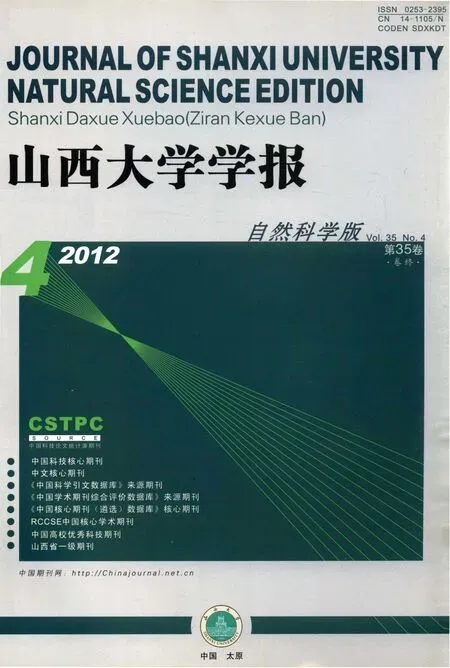* 两组分玻色-爱因斯坦凝聚体中矢量孤子的动力学性质
周艳珍,张素英
(山西大学 理论物理研究所,山西 太原 030006)
*两组分玻色-爱因斯坦凝聚体中矢量孤子的动力学性质
周艳珍,张素英*
(山西大学 理论物理研究所,山西 太原 030006)
通过数值求解异种两组分玻色爱因斯坦凝聚体在弱囚禁势中的运动方程来讨论其矢量孤子解的动力学性质.研究表明,种内和种间相互作用强度满足不同的条件时,会形成亮亮孤子、亮暗孤子和暗暗孤子等不同的矢量孤子解.其中亮亮孤子和亮暗孤子是稳定的,而暗暗孤子很不稳定.适当改变种间相互作用强度,亮、暗孤子之间能够相互转换.
两组分玻色爱因斯坦凝聚体;矢量孤子;稳定性
玻色-爱因斯坦凝聚(简称BEC)中的暗、亮物质波孤子的成功观测及其潜在的应用前景,使BEC中的物质波孤子成为当前低温物理和凝聚态物理研究领域的研究热点之一.孤子是非线性物质波的存在形式,能够很好地保持空间轮廓,稳定地传播,它分为亮孤子和暗孤子两类.目前,多组分BEC由于其具有复杂的量子相位[1]和在单组分BEC中所没有的性质已成为研究暗、亮孤子的焦点之一.而且,理论[2-5]和实验[6-7]的研究都表明异种两组分BEC系统中种间相互作用强度起着很重要的作用[8-9].本文通过数值模拟的方法研究了两组分玻色-爱因斯坦凝聚体(g11<0且g22>0)中矢量孤子在弱囚禁势中的动力学性质,并通过调节种间相互作用强度(实验上采用Feshbach共振技术实现[10-11])研究了孤子之间的相互转换问题.
1 理论模型
两组分玻色-爱因斯坦凝聚体的平均场动力学控制方程如下[2-4]:


2 不同的矢量孤子解

当无束缚外势时,即λ1=0,λ2=0,方程(1)和(2)存在以下四种情况的矢量孤子解[12]:

为了得到不同的矢量孤子解,我们定义下面两个量:


图1 种间相互作用强度g12取不同值时凝聚体内形成不同的矢量孤子所对应的分段图,其中κg 11<g 22/κ,g 11<0,g 22<0Fig.1 Chart in stages of vector solitons in Bose-Einstein Condensates with different values of the interspecies interaction strength g 12,withκg 11<g 22/κ,g 11<0 and g 22<0
第二类情况——g11<0,g22>0,g12可以调节,我们可以划分出下面三个区域(如图2,P666):
f.g12∈(-∞,κg11],此时Q1>0,Q2<0,形成亮 -亮孤子;
g.g12∈(κg11,g22/κ],此时Q1>0,Q2>0,形成亮 -暗孤子;
h.g12∈(g22/κ,+∞),此时Q1<0,Q2>0,形成暗 -暗孤子;

图2 种间相互作用强度g12取不同值时凝聚体内形成不同的矢量孤子所对应的分段图,其中κg 11<g 22/κ,g 11<0,g 22>0Fig.2 Chart in stages of vector solitons in Bose-Einstein Condensates with different values of the interspecies interaction strength g 12,withκg 11<g 22/κ,g 11<0 and g 22>0


图3 种间相互作用强度g 12取不同值时凝聚体内形成不同的矢量孤子所对应的分段图,其中κg 11<g 22/κ,g 11>0,g 22>0Fig.3 Chart in stages of vector solitons in Bose-Einstein Condensates with different values of the interspecies interaction strength g 12,withκg 11<g 22/κ,g 11>0 and g 22>0
关于亮-亮孤子的性质和暗-亮孤子的性质在异种两组分玻色-爱因斯坦凝聚体(g11>0且g22>0)中已经有大量的研究[13-14].我们采用数值模拟的方法主要讨论了在异种两组分玻色-爱因斯坦凝聚体(g11<0且g22>0)中亮-亮孤子、亮-暗孤子和暗-暗孤子的稳定性及其相互转换.
3 不同孤子的稳定性
两种类玻色-爱因斯坦凝聚体中,我们选定第一种类为7Li原子,第二种类为23Na原子,并且种内相互作用强度满足g11<0,g22>0,种间相互作用强度g12可以调节.此条件满足上面所列三类情况中的第二类情况,g12满足不同的条件时可以形成亮-亮、亮-暗和暗-暗三种不同孤子对.下面我们通过数值模拟实验来研究这三种孤子的稳定性.初始态(t=0)分别选用精确解(3)-(8),代入方程(1)和(2)进行动力学演化.结果表明,亮-亮孤子和亮-暗孤子在弱囚禁势中都能够稳定地传播,如图4和图5(P667)所示.而暗-暗孤子很不稳定,迅速地被破坏,且由于种间强大的排斥作用,彼此远离,如图6(P667)所示.
另外,可调相互作用的两组分玻色-爱因斯坦凝聚体中不同的孤子之间可以相互转换,如图7所示.首先,我们选择一对速度为零的亮 -暗孤子且种间相互作用强度满足g12∈(κg11,g22/κ],代入方程(1)和(2)进行动力学演化,然后在t=5时将种间相互作用强度g12瞬间变为小于κg11的值,继续动力学演化.由于g12<κg11,满足Q1>0,Q2<0,所以凝聚体内亮-暗孤子在t=5时转换为亮-亮孤子,且不同种类凝聚体中形成的亮孤子经过几次碰撞后合并为一个新的亮孤子.
4 结论

图4 在弱囚禁势中亮-亮孤子的动力学演化图其中g 11=-3.47,g 22=5.89,g 12=-3,κ=7/23,λ1=λ2=0.12,η=1.5,v=0.8Fig.4 Dynamic evolution of bright-bright solitons in weak longitudinal trap with g 11=-3.47,g 22=5.89,g 12=-3,κ=7/23,λ1=λ2=0.12,η=1.5 and v=0.8

图5 在弱囚禁势中亮-暗孤子的动力学演化图其中g11=-3.47,g22=5.89,g12=3,κ=7/23,λ1=λ2=0.12,η=1.5,v=0.4Fig.5 Dynamic evolution of bright-dark solitons in weak longitudinal trap with g 11=-3.47,g 22=5.89,g 12=3,κ=7/23,λ1=λ2=0.12,η=1.5 and v=0.4

图6 在弱囚禁势中暗-暗孤子的动力学演化图其中g 11=-3.47,g 22=5.89,g 12=30,κ=7/23,λ1=λ2=0.12,η=1.5,v=0Fig.6 Dynamic evolution of dark-dark solitons in weak longitudinal trap with g 11=-3.47,g 22=5.89,g 12=30,κ=7/23,λ1=λ2=0.12,η=1.5 and v=0

图7 在弱囚禁势中亮-暗孤子相互转换的动力学演化图.初始态与图5相同取g 11=-3.47,g 22=5.89,g 12=3,在t=5后,种间相互作用强度变为g12=-20,其它参数不变,其中κ=7/23,λ1=λ2=0.12,η=1.5,v=0Fig.7 Dynamic evolution of the mutual transforming bright and dark solitons in weak longitudinal trap withg 11=-3.47,g22=5.89,g12=3 initially,and the interspecies interaction strength is changed tog 12=-20 at t=5,other parameters are changeless,andκ=7/23,λ1=λ2=0.12,η=1.5,v=0
本文对可调相互作用的异种两组分玻色-爱因斯坦凝聚体中孤子的研究表明,种内和种间相互作用强度满足一定的条件时,会形成不同的矢量孤子解.通过数值模拟方法,调节相互作用强度,对所形成的亮-亮孤子、亮-暗孤子和暗-暗孤子在弱囚禁势中进行动力学演化,结果显示亮-亮孤子和亮-暗孤子是稳定的,而暗-暗孤子很不稳定.此外,当改变组分间相互作用强度时,亮、暗孤子之间可以相互转换.这对进一步研究矢量孤子在多种类BEC中的性质有重要的意义.
[1] Alon O E,Streltsov A I,Cederbaum L S.Zoo of Quantum Phases and Excitations of Cold Bosonic Atoms in Optical Lattices[J].PhysRevLett,2005,95:030405.
[2] Ho T L,Shenoy V B.Binary Mixtures of Bose Condensates of Alkali Atoms[J].PhysRevLett,1996,77:3276-3279.
[3] Esry B D,Greene C H,Burke J P,etal.Hartree-Fock Theory for Double Condensates[J].PhysRevLett,1997,78:3594-3597.
[4] Pu H,Bigelow N P.Properties of Two-Species Bose Condensates[J].PhysRevLett,1998,80:1130-1133.
[5] Pu H,Bigelow N P.Collective Excitations,Metastability,and Nonlinear Response of a Trapped Two-Species Bose-Einstein Condensate[J].PhysRevLett,1998,80:1134-1137.
[6] Myatt C J,Burt E A,Ghrist R W,etal.Production of Two Overlapping Bose-Einstein Condensates by Sympathetic Cooling[J].PhysRevLett,1997,78:586-589.
[7] Modugno G,Ferrari G,Roati G,etal.Bose-Einstein Condensation of Pota-ssium Atoms by Sympathetic Cooling[J].Science,2001,294:1320.
[8] Thalhammer G,Barontini G,Sarlo L De,etal.Double Species Bose-Einstein Condensate with Tunable Interspecies Interactions[J].PhysRevLett,2008,100:210402.
[9] Papp S B,Pino J M,Wieman C E.Tunable Miscibility in a Dual-Species Bose-Einstein Condensate[J].PhysRevLett,2008,101:040402.
[10] Roberts J L,Claussen N R,Burke J P,etal.Resonant Magnetic Field Control of Elastic Scattering in Cold85Rb [J].PhysRevLett,1998,81:5109-5l12.
[11] Stenger J,Inouye S,Andrews M R,etal.Strongly Enhanced Inelastic Collisions in a Bose-Einstein Condensate near Feshbach Resonances[J].PhysRevLett,1999,82:2422-2425.
[12] Liu X X,Pu H,Xiong B,etal.Formation and Transformation of Vector Solitons in Two-Species Bose-Einstein Condensates with a Tunable Interaction[J].PhysRevA,2009,79:013423.
[13] Pérez-García Víctor M,Beitia Juan Belmonte.Symbiotic Solitons in Heteronuclear Multi-component Bose-Einstein Condensates[J].PhysRevA,2005,72:033620.
[14] Busch Th,Anglin J R.Dark-Bright Solitons in Inhomogeneous Bose-Einstein Condensates[J].PhysRevLett,2001,87:010401.
Dynamic Properties of Vector Solitons in Two-species Bose-Einstein Condensates
ZHOU Yan-zhen,ZHANG Su-ying
(InstituteofTheoreticalPhysics,ShanxiUniversity,Taiyuan030006,China)
We discuss the dynamic properties of the vector solitons of two-species Bose-Einstein condensates in weak trapping potential by numerically solving its corresponding equations of motion.The results show that under some condition,different intraspecies and interspecies interaction coefficients result in different types of vector solitons,such as bright-bright,bright-dark and dark-dark vector solitons.Moreover,the bright-bright and bright-dark vector soliton are dynamically stable,while the dark-dark vector soliton is dynamically unstable.In addition,the different types of vector solitons can be transformed by tuning the interspecies interaction via Feshbach resonance.
two-species Bose-Einstein condensates;vector soliton;stability
O469
A
2011-09-27;
2012-02-24
国家自然科学基金(10972125);高等学校博士学科点专项科研基金(20111401110004);山西省自然科学基金(2010011001-2);山西省留学回国人员科研基金
周艳珍(1988-),女,山西忻州人,研究方向:凝聚态物理.E-mail:Zhouyanzhen1988@163.com.*张素英(1967-),女,山西人,教授,博士生导师,研究方向:数学物理、计标物理.E-mail:zhangsu@sxu.edu.cn
0253-2395(2012)04-0664-05
book=668,ebook=358

